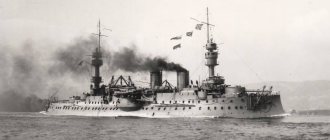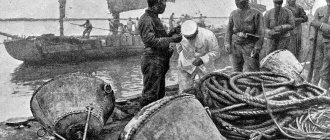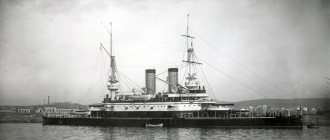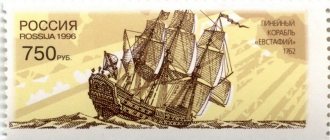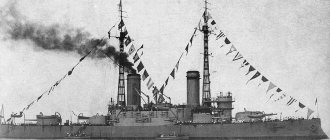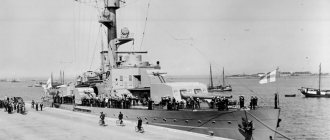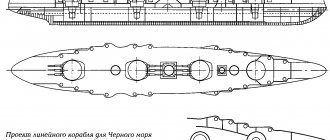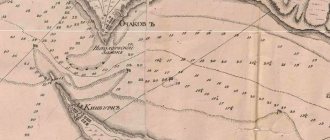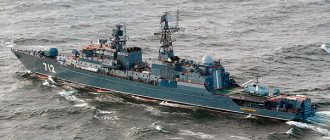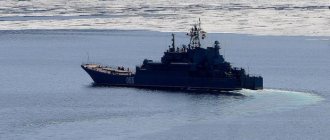Attention! The series has been discontinued!
The squadron
battleship “Tsesarevich” is the second partwork of the “Flotilla of the Russo-Japanese War” series as part of the “ Ships of Russia ” magazine.
Publisher: Modelist LLC (Samara). The squadron battleship "Tsesarevich" was built in France by order of the Russian Empire. He took part in the Russian-Japanese and First World Wars. Subsequently, based on the drawings of this ship, a whole series of ships of the Borodino type was built. Construction of the ship began in 1899 in Toulon. The launch took place on January 23, 1901, but over the next two years various modifications were made to the design. As a result, the “Tsesarevich” entered service only in 1903, almost with the beginning of the Russian-Japanese War. At the end of February 1904, during a battle with a Japanese destroyer, our battleship was damaged by a torpedo. However, the repairs did not take long, and the ship was soon put back into service. In September of the same year, after breaking into the port of Kiao Chao, the battleship was interned until the end of the war. After the ship was returned to Russia, it became part of the Baltic Fleet. In 1907, after a radical restructuring, she was transferred to the class of battleships. In March 1917, the ship was renamed “Citizen”. He also had a chance to test himself as an icebreaker. In difficult ice conditions in December 1917, he made the transition from Helsingfors (Helsinki) to Kronstadt. We can say that this was the last voyage of the ship. Since May 1918, it was accepted for long-term storage. During the Civil War, the artillery was removed from the Citizen. It was already used on land fronts, as well as on river and lake flotillas. The ship completed its service in 1924. Was dismantled for metal.
Characteristics of the battleship "Tsesarevich"
- Length: 118.5 m Width: 23.2 m Displacement: about 13 thousand tons Draft: 7.9 m Speed: 18 knots Cruising range: 2805 miles Crew: more than 800 people Armament: 305mm - 4 152mm guns - 12 75mm guns – 10 37mm guns – 11 guns Machine guns – 2 Torpedo tubes – 4
Model of the battleship Tsesarevich
The squadron battleship "Tsesarevich" continues the "Flotilla of the Russian-Japanese War" series from Modelist LLC. This is the second model of this collection (the first is the 1st rank cruiser “Varyag”). The assembly of the model is planned for 80 issues of the magazine, once a week.
Model parameters:
- Scale: 1:200 Length: 58.6 cm Width: 11.6 cm Height: 30 cm
to manufacture parts of the “Tsarevich” model :
- HDF – 3 mm
- Brass
- ABS plastic
- Steel bar
- Monofilament
- Birch slats
- Birch veneer
Modelist LLC continues its tradition and, as before, uses the developments of only domestic specialists. All parts are made from domestic materials at Russian enterprises. The model completely replicates the appearance of a real ship. It recreates in great detail all the components and gun superstructures that existed on the battleship. However, assembly of the model, thanks to detailed instructions, will be accessible to modellers of any level.
16. Qingdao instead of Vladivostok
16. Qingdao instead of Vladivostok
Having fallen behind the squadron, the Tsesarevich had already completely lost its course towards Port Arthur. Destroyer attacks were repulsed by turning their stern towards them. Almost constantly changing course to all points, we completely lost our orientation. The damage to the ship was visually impressive, but did not significantly affect its combat effectiveness. The night allowed us to deal with some of them, and therefore, after consultation with the officers, senior officer D.P., who remained in charge of the commander. Shumov decided to break through to Vladivostok. At Port Arthur, a ship that was lagging behind and did not know its way could be intercepted by the Japanese. Going south, one could expect to get lost at sea and slip through the Tsushima Strait at night.
Coal consumption due to hole in. pipe, was, of course, higher than normal, but at economic speed, as the senior mechanic confirmed, it should have been enough to reach Vladivostok. A return to Port Arthur was considered futile. There the ship could only expect an inglorious death under the fire of Japanese siege batteries. The southward course was guided by the North Star, keeping it astern. Already in the darkness, “Askold” passed close, and a little later - “Diana”. But the cruisers, considering themselves to be acting independently, did not want to join their flagship ship, and the Tsesarevich did not have time to give them a signal, perhaps they were mistaken for the enemy in the dark or simply not noticed.
V. Semenov in his “Reckoning” does not mention the meeting with the “Tsarevich”. The chance to gather a whole detachment at the head (Grozovoy was traveling with Diana) was missed. On the way, the searchlights, as was established on the squadron, did not reveal themselves, and they fired at the destroyers snooping around only when one of them clearly went on the attack. The night finally dispelled fears. Even for a single ship, with reliable blackout, careful control and disciplined gunners (they only fired at the officer’s command), the destroyers turned out to be not dangerous. The incoming morning fog also turned out to be useful. All five observed attacks were successfully repelled.
One of the destroyers, as if sensing the ship in the darkness (maybe even by the smell of smoke from the chimneys), approached and managed to fire a mine shot. Fire from the right bow turret immediately destroyed it, but the torpedo it fired, leaving a clearly visible phosphorescent trail, inevitably approached the starboard side. There was no longer any way to evade, the explosion seemed inevitable. But before reaching the side 6–7 m, the torpedo abruptly changed its path and disappeared astern. From midnight the attack stopped, but before dawn a detachment of ships was discovered, sailing nearby on the same course. They avoided the unwanted meeting by turning and disappeared into a strip of rolling fog.
The morning of July 29 was encouraging. The weather was clear, the fog had disappeared, the horizon was clear. It was possible to mobilize all forces and begin to eliminate the most significant damage. But the decision unanimously made by the officers to break through to Vladivostok was met with objection from the commander who had come to his senses. The commander, who had suffered shock and serious concussion and was wounded in the head and arm, late in the evening (at about 11 p.m.), despite the protests of the doctors, demanded to be taken to the conning tower. Here he spent time repelling mine attacks, and the next morning, having assessed, as it seemed to him, the picture of serious damage to the ship, he recognized it, as he put it before the investigative commission, as “terrible.”
By that time, Rear Admiral Matusevich had also come to his senses. Both of them decided that before breaking through to Vladivostok, it was necessary to go to the German port of Kiao-Chao (Qingdao) for repairs and replenishment of coal reserves. Using the support of the chief of staff, the commander did not consider it necessary to convene the military council again, and the officers, taken by surprise by the superior “initiative,” did not find it possible to protest unanimously and decisively. Reliving in his soul again and again those significant circumstances for fate, having already become a captain of the 2nd rank, V.K. Pilkin in 1911. Wrote by P.A. Fedorov: “... In my soul I cannot forget the important mistakes I made: agreeing to Shumov’s proposal to go to Vladivostok and lack of perseverance when the commander did not listen to Nenyukov, me and Spolatbog and turned to Qingdao.”
“Tsesarevich” in Qingdao
Throughout the night, the ship's manager, D.P. Shumov (the commander was only present in the control room) could not convince the commander who had come to his senses. In response to his report and arguments about the officers’ intention to turn south to break through to Vladivostok, the commander announced his other decision: “he will not go to Vladivostok, since the battleship is badly damaged, but will go to Tzingtau.” The arguments of lieutenants Nenyukov, Pilkin and midshipman Spolatbog that if he doesn’t want to go to Vladivostok, then he should go further to the south, but not to Qingdao, had no effect on him either.” Thus, the census, having given an unsuitable commander to officers who were concerned for the honor of their ship, once again showed itself to be harmful. Commander Ivanov had enough vital energy and leadership just before he arrived in Qingdao. Here on July 30, completely, in his words, “exhausted from loss of blood and from a terrible headache with dizziness,” he safely left the ship for a shore hospital, and the ship was again handed over to the care of a senior officer. He stayed in the hospital until September 22 and thus, having driven the ship into a trap, he himself avoided the consequences of his own decision and returned comfortably to Russia.
It was impossible not to understand that by making a huge detour south to Qingdao, the ship lost the chance of a surprise breakthrough and, revealing itself, allowed the Japanese to prepare forces for interception. The possibility of repairs, which for some reason commander Ivanov was counting on, was also problematic. The Germans, feigning neutrality, might not have allowed this repair. It was more realistic to rely on one’s own strength, which could cope with unfastening the broken mast and repairing the broken chimney. The ship had enough funds and materials for this. Light constructions of the combat top, bulwarks of towers and bunk nets could be used. The extensive experience accumulated in the Russian fleet was summarized in the VKAM collection “Damage on ships and their correction by ship means”, published in 1898 and probably present in the ship’s library. But this issue was not raised in the Investigative Commission.
Bringing the ship fully armed was not an insurmountable task. After all, not a single gun was hit on the ship. All towers and all 75-mm battery artillery remained in action. By morning, we had established both control from the conning tower and communication with the engine rooms. In the southeast quarter we were able to determine the compass deviation. n But upon arriving in Qingdao on the evening of July 29, the commander was in no hurry to issue orders to replenish coal reserves and order the materials necessary for repairs. Nor was he inspired by the example of Novik and Besshumny, who had come earlier and were already preparing to leave for the breakthrough. Even worse, Captain 1st Rank Ivanov found it convenient to evade the recommendations that the commander of the Fearless, Lieutenant P.L., approached him for. Trukhachev (1867–1916).
Arriving on the morning of July 30 along with the “Merciless,” he apparently believed that the ships that had broken through should go to Vladivostok together. Having assumed overall command and, with the help of his team, speeding up the replenishment of coal reserves on the destroyers, the Tsesarevich could take an entire detachment to sea. Depending on the situation, he could either make a breakthrough to Vladivostok or go south to wait for the arrival of the 2nd Pacific Squadron in hard-to-reach areas of French or even foreign colonies. A march to link up with the Vladivostok detachment of cruisers was not ruled out.
All this was quite realistic given the presence of special cruisers of the Voluntary Fleet in the Russian fleet. After all, their operations already at the beginning of the war caused a great stir among firms involved in military smuggling. It was planned to widely develop cruising operations, which could be quite realistically connected with the fate of the ships that broke through. Let us remember that S.O. Makarov considered it quite possible that the battleship Oslyabya, captured at the beginning of the war in the Red Sea, would break through to Port Arthur (and, possibly, to Vladivostok).
But the commander of yesterday’s flagship and his staff did not find the strength to fully fulfill their duty and prevent disarmament in neutral Qingdao. The ships were left to their own devices and acted completely separately. "Novik", in a hurry to leave before morning, and not receiving help from the "Tsarevich", left the port with an incomplete supply of coal. This circumstance played, as it soon became clear, a fatal role in his fate. “Besshumny” made every effort to cope with repairs as soon as possible, before the Japanese arrived at the port, and have time to leave for the breakthrough. “Fearless,” waiting for its readiness, hurried to receive coal. There is no mention in the documents of assistance to the ships during all this time from the “Tsesarevich”.
Having declined all initiatives and being quite satisfied with the current circumstances, commander N.M. Ivanov retired from work with a sense of duty fulfilled. On the morning of July 30, he went ashore to a German hospital, leaving his ship to solve the problems he, Ivanov, had created on his own. Admiral Matusevich also ended up there. But the ship, despite the strange behavior of its two most senior commanders, did not give up. Hope for the possibility of repairs and a subsequent breakthrough was aroused by a telegram from Emperor Nicholas II transmitted to the ships on July 31, encouraging the crew “to be conscious of sacredly and honorably fulfilling their duty to the throne and homeland.”
Admiral Matusevich’s response telegram addressed to the head of the Naval Ministry expressed the feelings of reverence with which everyone on the battleship and destroyers received the “highly merciful words” of the emperor, and expressed wishes for “sending health and prosperity to the beloved sovereign, the emperor and the highly-born heir.” Further, loyal feelings and the unanimous desire of the ship crews were expressed to “again carry our lives to the glory of the throne and the fatherland.” Alas, reality did not confirm these sublime feelings of all-devotion to the throne. The Germans, however, in order not to expose the ships to Japanese attacks from the sea, transferred them to the internal basin on July 31, and the governor announced on August 1 that the Tsarevich was allowed a 6-day stay. It was explained by the need to bring the ships into the condition necessary to go to sea (but not for full combat readiness). On the day of arrival, the Besposhchadny was first required to leave the port within 24 hours (as was the Novik before that), and then, citing the permission of the German Emperor, the stay was extended until midnight from August 3 to 4.
But on August 2, the attitude of the usually kind German authorities suddenly changed. At 10 a.m., the command of Kaiser Wilhelm II was announced to the commanders of all ships to immediately lower their flags and disarm by 11 a.m. Everyone was at a loss as to the reason for such exceptional treachery. After all, in all the years preceding the war, Russian ships had become accustomed to the feelings of cordiality, hospitality and even friendship constantly expressed by the German authorities (especially in Kiel). Germany clearly sympathized with Russia in that war, and German ships loaded with coal were already preparing (under contracts concluded with private companies) to accompany the march of Z.P.’s squadron. Rozhestvensky.
But N.A. Matusevich, whether due to depression from the wound he experienced or excessive delicacy, did not even try to explain to the Germans the absurdity of their demands: ships that had begun repairs needed much more time to go to sea. He did not consider it necessary to use his right to be strong, which allowed him to simply ignore the dishonest German ultimatum. The authorities in St. Petersburg, as is often done in Russia and as just happened with the cruisers Petersburg and Smolensk operating in the Indian Ocean, chose to simply disown their ships. The unprofessionalism of the supreme authorities again showed itself in all its ugliness.
Without waiting for a response from St. Petersburg to his urgent request, Matusevich gave the order to the ships to obey German demands. The ships lowered their flags and began unloading ammunition ashore that same day. We handed over to the Germans locks from 75-mm guns, parts from locks of large guns and two covers of spool boxes for medium-pressure cylinders. They took all the guns and revolvers ashore, leaving only 50 for guard duty.
Damage to the pipe on the battleship “Tsesarevich” after the battle on July 28
That day, as if already knowing about what had happened, a Japanese destroyer showed up at the port. A quarrel with Germany was not part of the Japanese plans and they did not attempt to capture the battleship. Satisfied with the information about the disarmament of the battleship, the destroyer immediately left. The countdown for the imprisonment of ships has begun.
With ease, with one stroke of the pen, abandoning a magnificent warship, the construction of which alone took five years, this decision cannot be called anything other than a crime. However, they did even more wonderful things with “Diana” in Saigon. Despite the fact that the French authorities did not make any demands for disarmament and guaranteed that all repairs to the ship would be carried out, the order for disarmament was sent here too. And this happened on August 22, when the ship could, if desired, go to sea and probably join Z.P.’s squadron. Rozhestvensky. In the name of the Admiral General, the order was given by the head of the Naval Ministry, Vice Admiral Avelan. And in front of the wisdom of this order, one can only shrug.
So the St. Petersburg rulers, without knowing what they were thinking about, easily “surrendered” all the ships that had broken through. For some reason they were considered unnecessary for the war. Submitting to the will of the Admiral General, the Tsarevich also plunged into a new, now unimpeded, leisurely - for the entire war - repair period. Before the group could leave the ship before disarmament, as they did on the Diana, the battleship’s officers, along with the routine of the repair and shore service, began to comprehend the invaluable combat experience that had befallen them. After all, he could still be useful. How, once on August 1, 1904, the 2nd squadron of the Pacific Fleet began a campaign in Kronstadt.
Fate, too, did not leave the optimistic ship with its worries - it arranged so that one of the officers (flag officer of the headquarters, Lieutenant M.A. Kedrov) had the chance, like three officers of the Diana, to take part in the campaign and battle of the squadron Z.P. . Rozhestvensky. It is unknown with what attention (or whether it was even considered necessary) Zinoviy Petrovich paid attention to their experience, but Lieutenant Kedrov, who had the most information (flag officer of the headquarters of S.O. Makarov and V.K. Vitgeft), received an appointment that was far from the tasks of summarizing the experience - artillery officer on the cruiser (armed passenger ship) "Ural". The system, as if it had set itself the goal of destroying the fleet, remained true to itself.
Magazine Ships of Russia: Tsarevich
Each issue of the magazine includes:
- Attachment – parts for assembling a ship model;
- Convenient assembly instructions with photographs and a detailed description of the assembly procedure;
- Chronology of the battleship's service from the beginning of construction to its dismantling for metal;
- “Encyclopedia of Sea Knots” - each issue contains instructions for tying one or two knots.
Magazine Tsarevich recommended price: first issue – from 50 to 75 rubles
.
second issue - from 70 to 105 rubles
.
from the third issue - from 100 to 150 rubles
. Frequency: weekly
A total of 80 issues.
Room releases are not limited by any period:
Most of the parts for the model are manufactured in-house at Modelist LLC, and printing takes place in its own printing house. All this makes it possible not to limit the magazine’s circulation and not be strictly tied to any release dates. You can place an order for any published issue of the magazine whenever it is convenient for you. Start assembling it yourself and show it to your friends. They also have the opportunity to assemble a ship, starting with the first number. You don't have to worry about the magazine series ending suddenly. Modelist LLC officially declares that all 80 issues will be released.
